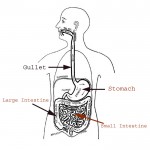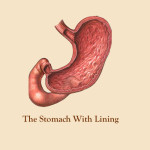Role of Saliva in Digestion
Saliva and Digestion are very closely related to each other; especially in the case of Starch (or Carbohydrates) Foods. Saliva is basically a juice secreted by some Glands called Salivary Glands; which help in melting and converting the taken Food in the form of Starch into Sugar (or Glucose) for absorption in the Body.
The Salivary Glands – The Juice Factories
Now, where does this Saliva in the mouth come from? It is poured out from the pouches of the cheeks, and from under the tongue, by some little living sponges, or juice factories, known as Salivary Glands.
All the juices poured out by these glands, indeed nearly all the Fluids or Juices in our bodies, are either Acid or Alkaline. By Acid we mean sour, or sharp, like vinegar, lemon juice, vitriol (Sulphuric Acid), and Carbonic Acid (which forms the bubbles in and gives the sharp taste to plain Soda-Water). By alkaline we mean “Soap-like” or flat, like Soda, Lye, Lime, and Soaps of all sorts. If you pour an acid and an alkali together – like vinegar and soda – they will “fizz” or effervesce, and at the same time Neutralize or “Kill” each other.
When the Digestion Process Starts:
As you would naturally suppose that the Process of Digestion would not begin until the food got well between our teeth; but, as a matter of fact, it begins before it enters our lips, or even before it leaves the table. If bread be toasted or freshly baked, the mere smell of it will start our mouths to watering; and, even the mere sight of food, as in a pastry cook’s window, with the glass between us and it, will start up this preparation for the Feast.
Good Appearance & Good Flavour of Food – Both are Important
This flow of Saliva in the mouth is of great assistance in moistening the bread while we are chewing it; but it goes farther than this. Some of the Saliva is swallowed before we begin to eat; and this goes down into the Stomach and brings word to the juices there to be ready, for something is coming. As the food approaches the Mouth, a message also is telegraphed down the nerves to the Stomach, which at once actively sets to work pouring out a digestive juice in readiness, called the “Appetite Juice”. This shows how important is, not merely a good appetite, but also attractive appearance and flavor in our Food; for if this Appetite Juice is not secreted, the Food may lie in the Stomach for hours before the proper Process of Digestion, or melting, begins.
The Use of the Saliva:
As the chief purpose of digestion is to prepare the food so that it will dissolve in water, and then be taken up by the cells lining the food-tube, The Saliva, like the rest of the body Juices, consists chiefly of Water. Nothing is more disagreeable than to try to chew some dry food – like a large, crisp soda cracker, for instance – which takes more moisture than the salivary glands are able to pour out on such short notice. You soon begin to feel as if you would choke unless you could get a drink of water. But it is not altogether advisable to take this short cut to relief, because the salivary juice contains what the drink of water does not – A Ferment, or Digestive Substance (Ptyalin), which possesses the power of turning the Starch in our food into Sugar. As starch is only very slowly soluble, or “melt-able,” in water, while sugar is very readily so, the saliva is of great assistance in this process of melting, known as Digestion. The changing of the Starch to Sugar is the reason why bread or cracker, after it has been well chewed, begins to taste sweetish.
The Role of Pancreas in Digestion:
Even with careful mastication, a certain amount of Starch will be swallowed unchanged. Nature has provided for this by causing another gland farther down the canal, just beyond the stomach, called the Pancreas, to pour into the food tube a juice which is far stronger in Sugar-Making power than the saliva, and this will readily deal with any Starch which may have escaped this change in the Mouth. Moreover, this “sugaring” of starch goes on in the stomach for twenty to forty minutes after the food has been swallowed.
Starchy foods, like Bread, Biscuit, Crackers, Cake, and Pastry, are really the only ones which require such thorough and elaborate chewing as we sometimes hear urged. Other kinds of food, like Meat and Eggs – which contain no Starch and consequently are not acted upon by the saliva – need be chewed only sufficiently long and thoroughly to break them up and reduce them to a coarse pulp, so that they can be readily acted upon by the acid juice of the stomach.




Share the Post